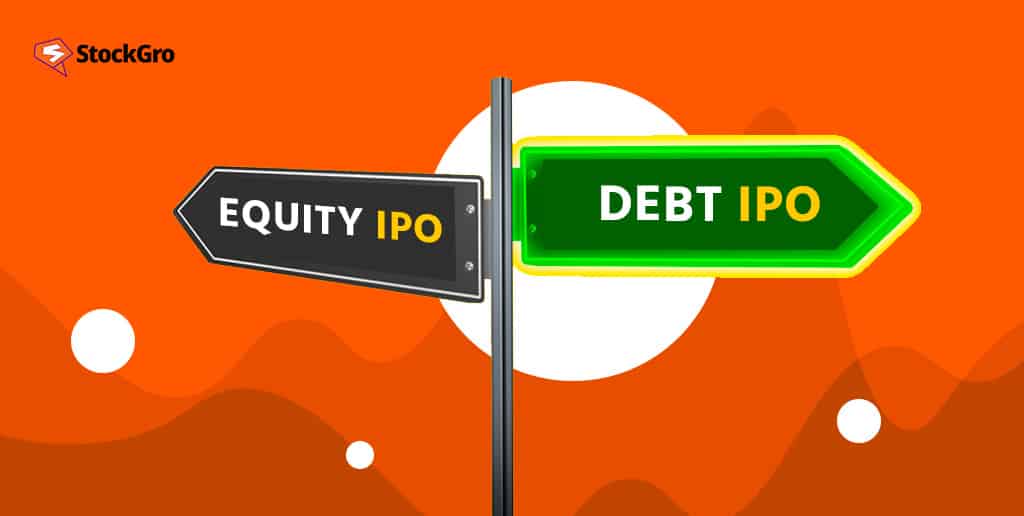
Every company needs capital to run its operations, payout its debt, and manage other aspects of the business. They can raise capital in different ways, and the most common method is to raise an IPO (Initial Public Offering).
Non-listed companies often choose IPOs to raise capital.A company can raise capital in two ways under IPO- Equity and Debt. However, there is a difference between debt and equity IPO, which you should be aware of.
A stock is a security in the equity market, whereas a bond is a complete security in the bond market. The most common asset classes investors use to build their portfolios are stocks and bonds. Both asset types have unique risk, return, and liquidity characteristics.
As a result, they are appropriate for various types of investors. Equities are appropriate for investors with high-risk tolerance because they are high-risk assets.
Bonds, however, are less risky than equities in comparison. As a result, they are appropriate for investors with modest degrees of risk tolerance. Once you know about the basic difference between bonds and IPO, you can go ahead to invest.
Let’s understand the difference between the two.
You may also like: Do all technical analysis tools work equally well?
What is Equity IPO?
Private limited firms or unlisted businesses issue shares to raise money via the stock market. Potential investors are invited to put in money and become company shareholders.
The company is then listed on an exchange, and its stocks can be traded once the IPO is issued successfully.
These shares signify a portion of ownership and entitle the holders to a share of the company’s earnings. Furthermore, these shareholders also get decision marking rights through voting.
Startups or established businesses looking to increase their operations, invest in R&D, or buy new assets prefer equity IPOs.
Two types of equity IPOs-
- Fixed Price Issue: In a fixed-price IPO, the corporation determines the share price before the issuance.
- Book Building Issue: When a company issues a book-building issue, investors must submit bids within a certain price range. The company sets a price based on interest and distributes shares accordingly after reviewing bids.
What is a Debt IPO?
Bonds and other debt instruments are issued to the public as part of debt IPOs. A company generates financing through a debt IPO by borrowing money from investors who buy these bonds.
Debt IPOs don’t involve ownership holdings in the company, unlike equity IPOs. Investors receive interest payments and principal repayment as creditors, not monthly.
Established businesses that need more funding for operations, debt repayment, or specific initiatives frequently consider debt or bond IPO.
Companies issue Non-Convertible Debentures as borrowed money that they cannot convert into shares.These debentures come into two categories-
- Secured Debt IPO– Company assets secure NCDs and debt IPOs, allowing creditors to sell them to pay off the debt in case of missed payments.
- Unsecured NCD or IPO– The company’s assets do not secure unsecured NCDs or Debt IPOs. They are riskier as a result and offer higher returns than secured NCDs to offset the risk that the borrowers take on.
Also Read: Understanding how a secondary offering IPO works & types
What are the differences between Debt IPO and Equity IPO?
One key factor that distinguishes debt IPOs and equity IPOs is the use of the instrument for raising capital.
| Basis of Difference | Bond IPO | Equity IPO |
| Ownership vs. Borrowing | Debt IPOs require the company to borrow money from investors | Equity IPOs allow businesses to raise money by selling ownership holdings. |
| Types | Government Bonds, Corporate Bonds, Municipal Bonds, and Asset-Backed Securities | Ordinary Shares, Preference Shares, Bonus Shares, Sweat Equity, and Employee Stock Options (ESOPs). |
| Risk and Return | Bonds offer fixed interest payments and repayment assurance, but are vulnerable to inflation risk and may not provide great long-term returns due to money losing value over time. | Equity IPOs have high risk due to fluctuating stock prices, which can lead to major losses. Market and business risks are the two main hazards associated with equities. |
| Voting Rights | Debt IPO owner don’t possess any voting rights because they are just creditors of the company | Equity IPO holders carry complete voting rights, mean they can involve in the decision-making area. |
| Issuer | Governments, financial institutions, and businesses issue bonds to borrow substantial quantities of money for purposes such as growth, acquisition, or other goals. | Only businesses looking to raise capital for capital projects, increase company growth, or dilute owner shares issue equity stocks. |
| In case of insolvency | If the company files for bankruptcy, bondholders are given preference. In other words, bondholders are paid first when a business is liquidated. | After all debt obligations are satisfied, funds are distributed to equity holders. |
| Trading Platform | Bonds can be bought in the primary market and sold in the secondary market before they mature. | Stocks can be traded on NSE and BSE. |
| Market perception | Debt IPOs offer consistency and reliability, drawing risk-averse investors seeking dependable returns. | IPOs signal growth and potential, attracting hopeful investors. |
The Bottom Line
Both equity IPOs and debt IPOs are distinct ways for businesses to raise cash, and each has special traits, benefits, and drawbacks of its own. Therefore, conducting a thorough study before making a stock or debt IPO investment would be preferable.
A company’s financial objectives and market circumstances influence the decision between the two. Before taking part in either sort of IPO, investors must also consider their investment goals.



Leave a Comment